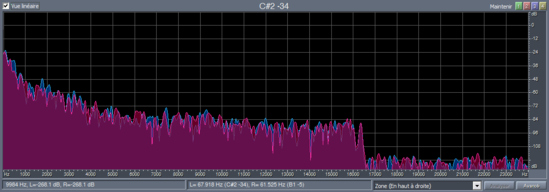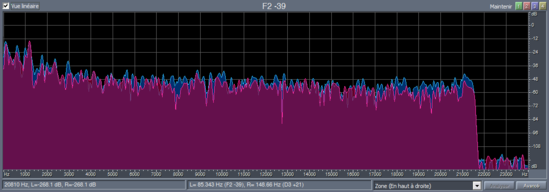The Sealed Esoteric History -moon- (秘封活動記録-月-) review, part3 (picture and sound quality)
The technical side: what is the quality like?
That’s why I’m sad I can’t post screenshots. You’ll only have my descriptions as to how to gauge the overall quality.
As said earlier, we have 4 files. 2 720p files of 318MB of size and 2 1080p files of 1.8GB of size. The one I watched is the 1080p subbed one. This one should have been almost flawless considering the high bitrate (8Mbps variable bitrate AVC)… except that’s not totally the case. Relatively calm parts look clean, but once it begins to have some action, some degradation and blocking start to appear (I also checked frames individually on my computer too, with a 23” Asus IPS full HD monitor, if that is any comfort to you). Indeed, action go generally pretty fast so you’ll not likely to notice it. But beware if you’re watching it on a 50+ inch TV. I really wish they used constant CRF instead of what I assume to be 2-pass encoding.


On the left, we have a calm scene and on the right a busy one (battle with Suika). I know I didn’t have permission to show direct screenshots, but Idon’t think this should be harmful as the product is not really recognizable directly. Notice the quality drop when something busy happens. Thankfully, it doesn’t go worse than that.
Audio is AAC 317kpbs with a 48KHz sample rate on all files. Again, it should be flawless… except, hum! Analyzing the waveform through Adobe Audition’s frequency analyzer reveals a lot of frequency drops at as low as 16KHz on many BGMs, meaning they used lossy files as sources when editing! How can on earth someone serious could do that? Considering the music was most likely commissioned and not downloaded. On the other hand, opening and ending songs don’t show any sign of frequency drop (they go up to 20KHz but not over, which is okay for AAC audio). In all honesty, if you’re not obsessed with audio quality you won’t notice it. But if you’re an audiophile… Again, something to work on for the next time. Never use lossy files when editing sound if especially on something of that ambition, unless you have absolutely no other choice.


Click on each to enlarge. Notice how the graph doesn’t go above 16KHz on one of the BGMs heared throughout the OVA. That’s the sign of lossy audio thrown in the mix. Notice also how the ending only drops at 20KHz, which is what you would expect from AAC audio of a bitrate that high.
I quickly looked through one of the 720p files. I think it’s safe to consider them useless, unless the device you’re using to watch has trouble with high bitrate and 1080p files (some old BD players or multimedia gateways might struggle to play them), as they are basically Youtube-tier quality.
On the practical side, let’s look through the subtitles. Well, first surprise, they weren’t positioned with overscan in mind. They’re a bit too close to the bottom edge of the screen. On a CRT TV, subs might be either be plastered over the bottom edge of your bezel or cropped/eaten up. On a modern TV, it should be a bit better. I still recommend to disable overscan on your TV if you can, or unzoom the picture if using Kodi or XBMC on an old TV. The other complaint I have is how fast some of them are shown on screen. Most subs really go too fast to be read entirely. I think they wanted all their lines to be one-line only, which has never been a practical solution. With at least 2 lines, you are wasting a bit of screen space but at least you can read them (this is what Fantasy Kaleidoscope did perfectly). Also, it seems that TPD-Subs based their timing on the original subs, which made most of their lines a bit too fast to be read as a result. If you’re not a fast reader, that will be a problem. I highly recommend looking for lines that are too short in their file in order to merge them with lines after them (probably what I’ll do).
Now, something nobody will talk about (except me), the overall loudness. This is the aspect I feared the most. That was a pleasant surprise. In fact, only the opening and ending songs can be misleading as they are quite loud (in fact they reach 0dBFS). But the rest is fairly quiet with lots of headroom. I’m happy on this point.

Just like Fantasy Kaleidoscope, a lot of headroom is given so that various sound effects can breathe and so that it doesn’t sound squashed or assault our ears. However, opening and ending songs should have been lowered by at least 4 or 6dB, considering they were mastered with some loudness in mind (just like any other modern song, Touhou doujin music including ZUN’s own albums is no exception).
To be continued on part4 (personal verdict and some thoughts)